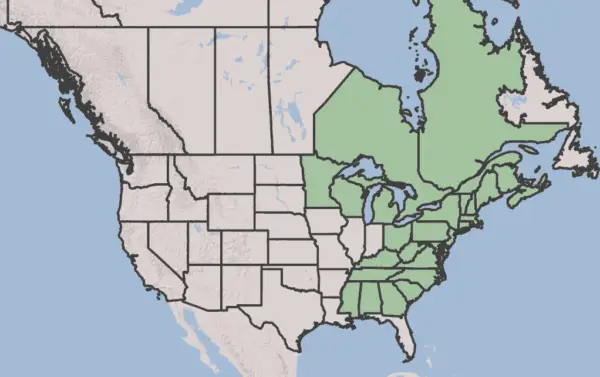Foamflowers have lots to offer, including gorgeous leaves and delicate flowers in the spring. They also thrive in shade or part shade gardens! The flowers are stunning, especially when 4+ are planted in a group (its Latin name—Tiarella—means ‘small tiara’.) In some warmer climates, the leaves stay evergreen. Do you have a shady spot in need of something delicate and memorable? Foamflowers are for you. Scroll on for planting tips.

Dig Deeper
Explore the history, types, and where to plant native Foamflower
Table of Contents
What are the benefits of planting Foamflower?
Planting native plants makes our yards and spaces gorgeous while helping the birds, butterflies, and animals (and helping save us time!) Here are three reasons why planting native is worth it:
- Without native plants, iconic animals like Monarch butterflies and songbirds won’t have the food or homes needed to survive
- Native plants save time and money: after the first year of getting established, native plants are happy with rain
- Foamflower is semi-evergreen: its leaves stay on the plant for most of the year.
- Native plants are gorgeous! Foamflowers are a perfect example of how beautiful and resilient native plants are—they are always the best choice for our gardens.

Where should you plant Foamflower?
In nature, Foamflower grow in naturally cool deciduous forests (or forests where the leaves drop in the fall.) To mimic this environment, plant Foamflowers in areas that have some shade and consistent moisture. Some inspiration for planting spots include:
- Underneath trees
- Alongside native shrubs
- Shade or part-shade gardens
- Rock gardens
- Edges or borders
- Groundcover: if you plant many, these can cover a wide area over time
Sun
Part Sun, Full Shade
Soil
Moist
Height
Short (under 2')
Lifespan
Perennial

When does Foamflower flower?
Foamflowers bloom in either the spring or early summer, depending on where you live. According to a 2022 research paper on Tiarella, “Flowering may occur from March–July but typically takes place during May in New Jersey.”
Plant as many Foamflowers together as you can
The more of these plants you plant together, the more dramatic it looks. Harriet Keeler’s 1916 book on wildflowers says it nicely, “A single Tiarella by itself is an exceedingly beautiful plant but it also grows in mass sufficiently to make an impression by numbers.”
In general, we recommend starting with 5+ plants at minimum, if you’re going for a dramatic display. The plants will increase in number year after year, expanding by stolons—which are thin root runners (like you see on strawberry plants.) After a few years, you’ll have a large expanse of Foamflowers.
And one more thing…
Planting Foamflower in a group can block out weeds!
When you plant Foamflowers in a group, their semi-evergreen leaves will successfully block out the light beneath them. This keeps weed seeds dormant (most weeds need sunlight to start growing.) This type of weed-blocking planting is called a “weed-excluding mat.” We will call it another reason why planting native is worth it.
Now that you’ve got Foamflower in your garden planning, you are probably wondering:
What are good Foamflower pairings?
Pair Foamflower with other native flowers and shrubs that also like woodland-inspired, part-shade environments. Some great pairings include:
Where can I buy Foamflower seeds or plants?
Finding native plants like Foamflower can sometimes be challenging—especially at conventional plant nurseries. We’ve tried to make this easier by putting together four ideas for sourcing native:
Where can I find seeds and plants?
Finding native plants can be challenging (we partly blame Marie Antoinette.) To make it easier, we’ve assembled four sourcing ideas.
Native Plant Nurseries
Our list of native nurseries makes finding one a breeze
Online Native Plant Sellers
We've included 100+ online resources to help
Society Plant Sales
Every state has a native plant society; find yours
Online Communities
Local Facebook groups are a great plant source
To sum it up, Foamflower is a delicate, memorable, and beautiful native flower that is perfect for shade or part-shade gardens. They are great for any Northeast, Mid-Atlantic, or Midwestern gardens, and many Southern gardens, too. Because it’s a perennial, plant once and it will come back year after year. Planting Foamflower in groups is a great way to landscape for drama—and weed-blocking abilities. Foamflower is semi-evergreen in seasonal climates and in warmer climates, their leaves will stay on year-round. Plant as many as you can in a shady spot, and sit back and watch the show in the spring or early summer. Happy planting!
Sources
- Fields, Douglas and Marjory Brzeskiewicz. Conservation assessment for Heart-leaved Foam-flower (Tiarella cordifolia). Report prepared for USDA Forest Service, Eastern Region. 2002, (PDF).
- Dodds, Jill S. Tiarella cordifolia var. cordifolia Rare Plant Profile. New Jersey Department of Environmental Protection, State Parks, Forests & Historic Sites, State Forest Fire Service & Forestry, Office of Natural Lands Management, New Jersey Natural Heritage Program, Trenton, NJ. (2022), 17 pp., (PDF)
- Keeler, Harriet L. (Harriet Louise), 1846-1921, Eloise P Luquer, and Mary Keffer. Our Early Wild Flowers: a Study of the Herbaceous Plants Blooming In Early Spring In the Northern States. New York: Scribner, (1916), 117.
- USDA, Heartleaf Foamflower








